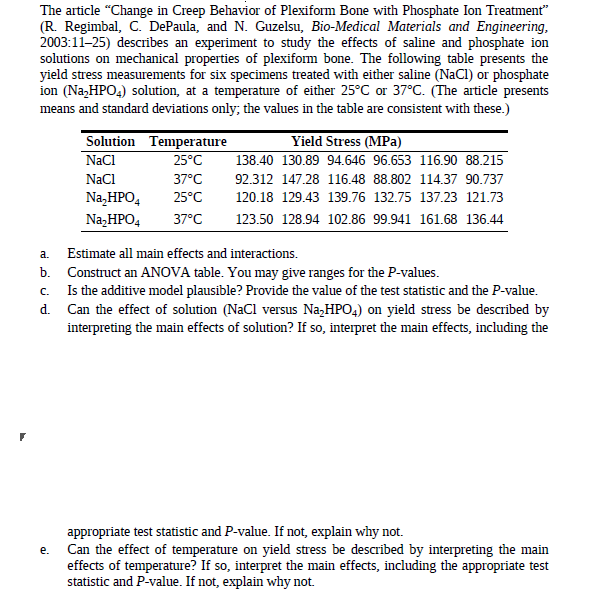The article "Change in Creep Behavior of Plexiform Bone with Phosphate Ion Treatment" (R. Regimbal, C. DePaula, and N. Guzelsu, Bio-Medical Materials and Engineering, 2003:11-25) describes an experiment to study the effects of saline and phosphate ion solutions on mechanical properties of plexiform bone. The following table presents the yield stress measurements for six specimens treated with either saline (NaCI) or phosphate ion (Na,HPO4) solution, at a temperature of either 25°C or 37°C. (The article presents means and standard deviations only; the values in the table are consistent with these.) Solution Temperature NaCl Yield Stress (MPa) 138.40 130.89 94.646 96.653 116.90 88.215 25°C NaCl 37°C 92.312 147.28 116.48 88.802 114.37 90.737 Na,HPO, 25°C 120.18 129.43 139.76 132.75 137.23 121.73 Na,HPO4 37°C 123.50 128.94 102.86 99.941 161.68 136.44 a. Estimate all main effects and interactions. b. Construct an ANOVA table. You may give ranges for the P-values. Is the additive model plausible? Provide the value of the test statistic and the P-value. d. Can the effect of solution (NaCl versus Na,HPO4) on yield stress be described by interpreting the main effects of solution? If so, interpret the main effects, including the C. appropriate test statistic and P-value. If not, explain why not. Can the effect of temperature on yield stress be described by interpreting the main effects of temperature? If so, interpret the main effects, including the appropriate test statistic and P-value. If not, explain why not. e.
The article "Change in Creep Behavior of Plexiform Bone with Phosphate Ion Treatment" (R. Regimbal, C. DePaula, and N. Guzelsu, Bio-Medical Materials and Engineering, 2003:11-25) describes an experiment to study the effects of saline and phosphate ion solutions on mechanical properties of plexiform bone. The following table presents the yield stress measurements for six specimens treated with either saline (NaCI) or phosphate ion (Na,HPO4) solution, at a temperature of either 25°C or 37°C. (The article presents means and standard deviations only; the values in the table are consistent with these.) Solution Temperature NaCl Yield Stress (MPa) 138.40 130.89 94.646 96.653 116.90 88.215 25°C NaCl 37°C 92.312 147.28 116.48 88.802 114.37 90.737 Na,HPO, 25°C 120.18 129.43 139.76 132.75 137.23 121.73 Na,HPO4 37°C 123.50 128.94 102.86 99.941 161.68 136.44 a. Estimate all main effects and interactions. b. Construct an ANOVA table. You may give ranges for the P-values. Is the additive model plausible? Provide the value of the test statistic and the P-value. d. Can the effect of solution (NaCl versus Na,HPO4) on yield stress be described by interpreting the main effects of solution? If so, interpret the main effects, including the C. appropriate test statistic and P-value. If not, explain why not. Can the effect of temperature on yield stress be described by interpreting the main effects of temperature? If so, interpret the main effects, including the appropriate test statistic and P-value. If not, explain why not. e.
MATLAB: An Introduction with Applications
6th Edition
ISBN:9781119256830
Author:Amos Gilat
Publisher:Amos Gilat
Chapter1: Starting With Matlab
Section: Chapter Questions
Problem 1P
Related questions
Question

Transcribed Image Text:The article "Change in Creep Behavior of Plexiform Bone with Phosphate Ion Treatment"
(R. Regimbal, C. DePaula, and N. Guzelsu, Bio-Medical Materials and Engineering,
2003:11-25) describes an experiment to study the effects of saline and phosphate ion
solutions on mechanical properties of plexiform bone. The following table presents the
yield stress measurements for six specimens treated with either saline (NaCI) or phosphate
ion (Na,HPO4) solution, at a temperature of either 25°C or 37°C. (The article presents
means and standard deviations only; the values in the table are consistent with these.)
Solution Temperature
NaCl
Yield Stress (MPa)
138.40 130.89 94.646 96.653 116.90 88.215
25°C
NaCl
37°C
92.312 147.28 116.48 88.802 114.37 90.737
Na,HPO,
25°C
120.18 129.43 139.76 132.75 137.23 121.73
Na,HPO4
37°C
123.50 128.94 102.86 99.941 161.68 136.44
a.
Estimate all main effects and interactions.
b. Construct an ANOVA table. You may give ranges for the P-values.
Is the additive model plausible? Provide the value of the test statistic and the P-value.
d. Can the effect of solution (NaCl versus Na,HPO4) on yield stress be described by
interpreting the main effects of solution? If so, interpret the main effects, including the
C.
appropriate test statistic and P-value. If not, explain why not.
Can the effect of temperature on yield stress be described by interpreting the main
effects of temperature? If so, interpret the main effects, including the appropriate test
statistic and P-value. If not, explain why not.
e.
Expert Solution
This question has been solved!
Explore an expertly crafted, step-by-step solution for a thorough understanding of key concepts.
This is a popular solution!
Trending now
This is a popular solution!
Step by step
Solved in 3 steps with 7 images

Recommended textbooks for you

MATLAB: An Introduction with Applications
Statistics
ISBN:
9781119256830
Author:
Amos Gilat
Publisher:
John Wiley & Sons Inc

Probability and Statistics for Engineering and th…
Statistics
ISBN:
9781305251809
Author:
Jay L. Devore
Publisher:
Cengage Learning

Statistics for The Behavioral Sciences (MindTap C…
Statistics
ISBN:
9781305504912
Author:
Frederick J Gravetter, Larry B. Wallnau
Publisher:
Cengage Learning

MATLAB: An Introduction with Applications
Statistics
ISBN:
9781119256830
Author:
Amos Gilat
Publisher:
John Wiley & Sons Inc

Probability and Statistics for Engineering and th…
Statistics
ISBN:
9781305251809
Author:
Jay L. Devore
Publisher:
Cengage Learning

Statistics for The Behavioral Sciences (MindTap C…
Statistics
ISBN:
9781305504912
Author:
Frederick J Gravetter, Larry B. Wallnau
Publisher:
Cengage Learning

Elementary Statistics: Picturing the World (7th E…
Statistics
ISBN:
9780134683416
Author:
Ron Larson, Betsy Farber
Publisher:
PEARSON

The Basic Practice of Statistics
Statistics
ISBN:
9781319042578
Author:
David S. Moore, William I. Notz, Michael A. Fligner
Publisher:
W. H. Freeman

Introduction to the Practice of Statistics
Statistics
ISBN:
9781319013387
Author:
David S. Moore, George P. McCabe, Bruce A. Craig
Publisher:
W. H. Freeman